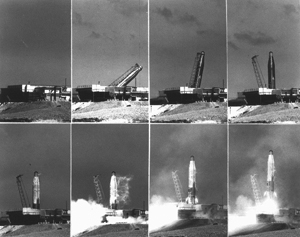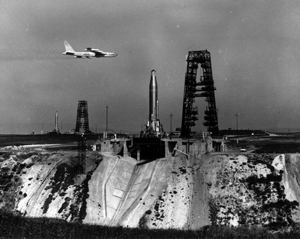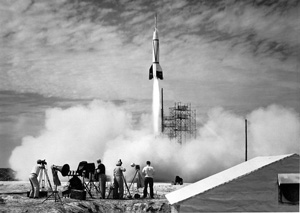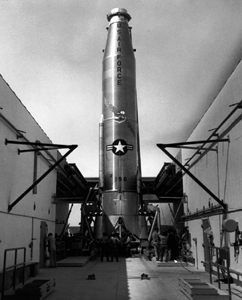Fifty years ago this month, the United States stepped briskly into the ICBM era, and it has never stepped out. Three long-range, liquid-fueled Atlas D missiles armed with nuclear warheads went on full combat alert at Vandenberg AFB, Calif., on Oct. 31, 1959. That moment will be commemorated at low-key events around the nation.
The fearsome Atlas missile instantly became a key element of Cold War deterrence. Its activation came amid a US-Soviet arms and space race kicked off by the Soviets launching Sputnik into orbit just two years earlier.
 |
Sequential images of an Atlas ICBM missile being raised, fueled, and launched. |
The fielding of the Atlas D was a milestone. It marked the onset of an age that peaked in 1978, when Washington had on alert 1,237 strategic land-based, nuclear-tipped missiles. The era of the ICBM continued more or less unabated for another decade, as the Air Force fielded the 10-warhead Peacekeeper missile.
In the past two decades, arms agreements and budget-driven cuts have whittled the force to 450 Minuteman IIIs, stationed in silos across the Great Plains. Though it has declined in number, the ICBM has maintained its status as queen of the strategic chessboard.
It began with Atlas. By the time the last ICBM-based variant was launched from Cape Canaveral, Fla., on Aug. 31, 2004, the missile had been launched 576 times, 477 of the launches successful.
Historians deem the Atlas program to be the most expensive and comprehensive engineering feat in history up to that time. It overshadowed even the World War II-era Manhattan Project that developed the atomic bomb. Atlas development yielded lessons that were applied to subsequent US rocket systems, including the Titan, the Minuteman, and the Saturn, which was used to carry the Apollo spacecraft to the moon in 1969.
“What strikes me today as an engineer and operator is how quickly we turned concepts into deployed capabilities back in the 1950s,” said Maj. Gen. Roger W. Burg, commander of 20th Air Force, which operates the nation’s ICBM force. “I am astounded at how rapidly they could take an idea, develop the technology to support it, and move it forward to a demonstrated capability and then deploy it as an operational system.”
Atlas deployment in 1959 capped a 14-year US effort to design, build, test, perfect, and deploy a long-range, land-based missile. In the mid-1950s, the push became urgent. The ICBM came to be viewed as a vital complement to Strategic Air Command’s force of long-range nuclear bombers, which some warned had become vulnerable to a Soviet surprise attack.
Project Paperclip
The theory was that the existence of a separate and survivable ICBM force would tamp down any temptation on the part of the Kremlin to try a pre-emptive strike on US bombers.
The ICBM lineage goes back to the World War II V-2 rockets developed by a team of German scientists led by rocket scientist Wernher von Braun. US military leaders became keenly interested in prospects for ballistic missiles after seeing Nazi forces, in the last days of World War II, use the 46-foot, liquid-fueled rockets to deliver 2,200-pound warheads 200 miles on trajectories reaching altitudes of 55 miles. The German Wehrmacht fired more than 3,000 V-2 rockets against Allied targets during World War II, killing an estimated 7,250 military personnel and civilians.
 |
Pictured in the late 1950s is Vandenberg AFB, Calif., where the first three Atlas D missiles armed with nuclear warheads went on full combat alert in 1959. |
After the war, President Harry S. Truman launched Project Paperclip, which transferred scientists from Germany’s pioneering rocket program to the US. Barely a month after the first German scientists arrived in September 1945, the Army Air Forces sought design proposals for long-range missiles from US firms.
By January 1946, engineers at Consolidated Vultee Aircraft Corp., led by Belgian émigré Karel J. Bossart, submitted innovative designs for two missiles.
One Bossart design was for a subsonic and winged cruise missile. The second was of a supersonic, rocket-powered ballistic missile that achieved extremely low structural weight by relying on single wall steel tanks held rigid by internal tank pressure. And in what became the keystone of the early US rocket program, Bossart created a so-called “stage-and-a-half” design that propelled payloads downrange by dropping the first stage on ascent.
By April 1946, the Army Air Forces had contracted with Convair to build 10 MX-774 Hiroc missiles to test Bossart’s concepts. Plans called for building a 32-foot-long missile with a fully fueled launch weight of 4,100 pounds that could reach an altitude of 40 miles. The contract called for three phases. Stage A, known as the “Teetotaler,” was a subsonic, self-guided cruise missile. Stage B, the “Old Fashioned,” used V-2 technology. Stage C, the “Manhattan,” was to be an ICBM.
By mid-1947, Convair had lost the cruise missile contract to Northrop Corp. and Martin Co. Defense cutbacks, coupled with Air Force skepticism at the time about the actual future of missiles, led to termination of the MX-774 contract three months before the scheduled first flight.
Using residual contract and corporate funds, Bossart eked out launches of three Stage B test vehicles at Point Loma, Calif., and from White Sands, N.M., between November 1947 and December 1948. Each test failed, but they generated crucial information that validated Bossart’s concepts—making the propellant tanks part of the airframe, using gimbaled gyroscopic-controlled motors, and installing a warhead that could separate in flight.
In the late 1940s, the newly created United States Air Force took note of the progress. The Berlin crisis in 1948, the Soviet Union’s first atomic test in 1949, and the start of the Korean War in 1950 quickly prompted the Pentagon to reinvigorate the drive for ICBMs.
DOD signed a new MX-1593 contract with Convair in 1951, calling on the firm to build upon proven concepts. USAF sealed a two-phase study that led to a contract in 1954 to build a ballistic missile that could lift and hurl a 7,900-pound warhead more than 5,700 miles and deliver it within 1,500 feet of a target.
It became known as Project Atlas, drawn from the mythic Greek giant bearing the weight of the Earth on his shoulders.
 |
The 1950 launch of the first rocket from Cape Canaveral, Fla., shown here, was a WAC Corporal rocket atop a V-2. |
A Missile Gap
The Pentagon remained enamored with the cruise missile concept, nonetheless. It spent more than $450 million over four years to develop, refine, and deploy the Snark and the Navaho, while providing only $26.2 million for the ICBM program.
However, continued failures of the cruise missiles and successful efforts to reduce the size of a thermonuclear warhead gradually cleared the way for a return to strong ICBM work.
Industry, outside experts, and Congress collaborated to shift momentum to the ICBM, as did competitive missile efforts by the Soviet Union that raised fears of a “missile gap.”
Convair, acquired by General Dynamics in 1954, presented a plan to the Air Force to accelerate ICBM development. The firm’s initial design called for a 90-foot missile with five engines producing the 600,000 pounds of total thrust thought needed to carry a 65-ton thermonuclear warhead into intercontinental range.
The Air Force had created the Strategic Missiles Evaluation Committee in October 1953. It was better known as the “Teapot Committee” or the “Von Neumann Committee” after its chairman John von Neumann, a Hungarian-born naturalized US citizen who was a key member of the Manhattan Project and a pioneer in the nuclear physics research that led to thermonuclear reactions and the hydrogen bomb.
The panel’s report in February 1954 contended that the US could surmount stubborn technological problems besetting development of ICBMs. H-bomb tests in the Pacific in 1954 bolstered this view; the tests proved that warheads could be made smaller and lighter—as little as 1,500 pounds—enabling Atlas designers to revamp their blueprints to create a more reliable three-engine design.
The tilt in favor of ICBMs got another boost from a RAND report that concluded operational ICBMs could be deployed to protect the United States by the early 1960s.
In May 1954, Gen. Thomas D. White, Air Force vice chief of staff, gave Project Atlas the Air Force’s highest priority. The Western Development Division of the Air Research and Development Command was established in Inglewood, Calif., to take over Project Atlas, a crash development program.
The effort was led by Gen. Bernard A. Schriever, a veteran of World War II B-17 combat missions who led WDD and its successor organizations from 1954 through 1966. Schriever harnessed the talents of some 18,000 scientists, more than 200 contractors, and 3,500 suppliers to develop and deploy the ICBM.
As Schriever later described it, “The Air Force’s Ballistic Missile Program represents a concerted effort of unprecedented magnitude jointly pursued by the most competent and widespread government, science, and industry teams ever assembled on a single project.”
The final push came from President Dwight D. Eisenhower, who created the Killian Committee in the fall of 1954, led by MIT President James R. Killian Jr. The panel reported in February 1955 that Atlas should be given the highest national priority in the face of Soviet progress on ICBMs.
 |
This Atlas D missile is shown at Vandenberg Air Force Base Complex B. It was later launched from Cape Canaveral in 1960. |
Eisenhower in September 1955 officially assigned top priority to ICBM development and deployment. The Atlas got the full go-ahead as Weapon System WS107A-1—a project known at Convair as Model 7. Eisenhower in March 1957 approved the plan for 40 Atlas and 40 Titan missiles, the backup system ordered developed in case the Atlas concept floundered.
The first Atlas A flight—a failure—took place June 11, 1957. It fell short of both target range (690 miles) and peak altitude (66 miles).
The first successful test flight came on the third attempt, Dec. 17, 1957. That success coupled with Moscow’s disturbing launch of Sputnik pushed Eisenhower and Congress to broaden the US space effort in 1958 and award SAC responsibility for the nascent ICBM forces in that year. By 1959, the $8 billion Atlas project boasted 33,000 workers. Roughly one-fourth of the funds were used to design and develop the missile. The remainder went to the construction of ICBM launch facilities such as Vandenberg.
After the first three missiles went on alert at Vandenberg that October 1959, the first operational Atlas D squadron became fully armed in 1960. It had soft launchpads known as “coffins,” slightly hardened above-ground shelters with removable roofs.
Atlas D deployments were adjusted year by year from six in 1959 to 32 in 1962 before declining to 13 on station by 1964 when the Titan and Minuteman ICBMs began entering the force.
At the outset, some airmen were leery of putting too much emphasis on long-range missiles. Gen. Curtis E. LeMay, though he was an ICBM supporter, emphasized that piloted bombers could always be recalled or redirected en route, while this was not so with ICBMs.
A Long History
In fact, the initial designation of the Atlas missile was that of a bomber—XB-65. It was not until 1955 that Atlas was redesignated SM-65, SM signifying “strategic missile.” It then became CGM-16. The letter C stood for “container” and the GM for “guided missile.” The rocket was stored in a semihardened container and prepared for launch by being raised and fueled in the open.
“The senior Air Force officer’s dedication to the airplane is deeply ingrained, and rightly so,” White said in 1957, “but we must never permit this to result in a battleship attitude”—a reference to the pre-World War II Navy’s preference for the big-gunned battlewagons over the still-unproven aircraft carrier.
Gen. Jack J. Catton, commander of Military Airlift Command and a former SAC officer, readily conceded the doubts. “I think there was apprehension more than opposition,” Catton recalled in an interview with Air Force historians. “We were not sure whether missiles were going to replace airplanes, or supplement them. More than opposition, I think we wanted to be shown the reliability and the performance capability of the new weapon.”
Burg, a career missileer, says of the early ICBM force: “A lot of officers … I learned from were in the original cadre. To me, the sacrifices and contributions they made [and] the discipline that became the watchword for the ICBM force—that’s still here. What they put together is still here.”
The Atlas was soon replaced by more advanced ICBMs, but it found work anyway, with variants carrying Mariner space probes that studied Mercury, Venus, and Mars, and with Agena target vehicles used during the Gemini program to develop and rehearse the orbital space rendezvous that were essential for lunar missions by the Apollo.
The Atlas also carried nine of the Mercury program missions from 1960 to 1963, including four manned missions beginning with John H. Glenn Jr. circling the Earth Feb. 20, 1962, 10 months after Soviet cosmonaut Yuri A. Gagarin.
The Atlas is remembered even as the Air Force prepares to transfer the ICBM force from Air Force Space Command to the newly established Global Strike Command. In a ceremony at Barksdale AFB, La., on Aug. 7, Burg’s team mapped plans to mark the 50th anniversary of Atlas D deployment. There was the dedication of an ICBM static display at Peterson AFB, Colo., and the presenting of “pioneer” awards to veterans of the early effort.
The ceremonies will be ignored by many Americans, but that goes with the assignment, says Burg.
“It’s amazing to me,” he said. “If you’re walking through the airport and people see your uniform and ask, ‘What do you do, General?’ and I tell them, they say, ‘Oh, really? Do we still do that?’”
Burg sees this as a classic good news-bad news situation.
“The bad news is, I wish more people knew what we did,” he said. “The good news is, they don’t feel they have to know. … That reinforces that we’re doing our job.”